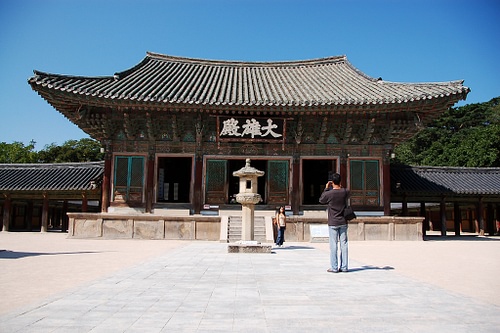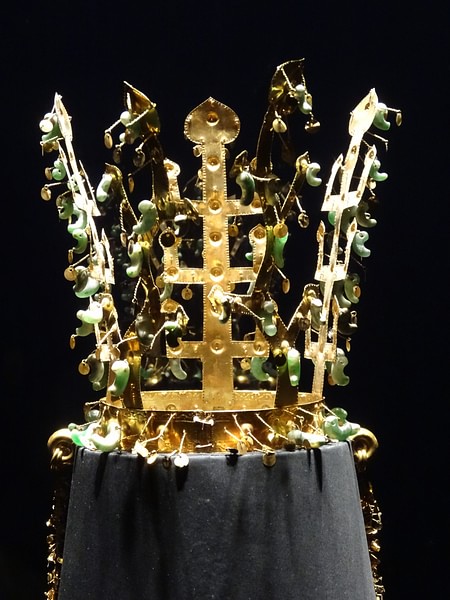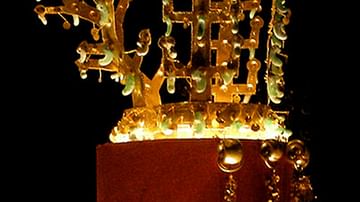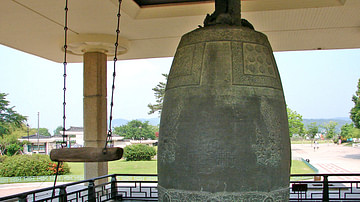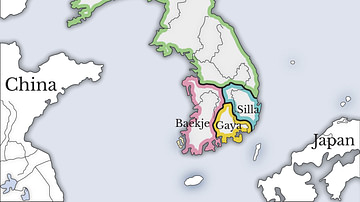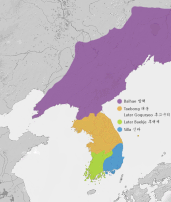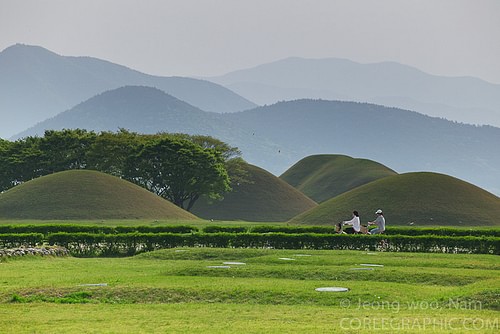
Gyeongju (Kyongju), formerly known as Seorabeol or Saro, was the capital of the Silla kingdom of ancient Korea from the 1st century BCE to the 10th century CE. Located in the south-east of the Korean peninsula, at its peak in the 9th century CE Gyeongju boasted 1 million inhabitants and 180,000 homes. The city today still has significant archaeological remains including the Cheomseongdae observatory, Bulguksa temple, Seokguram Grotto, pagodas, and many huge earth-mound royal tombs within which spectacular gold crowns and jewellery pieces have been excavated, fully justifying the capital's other name of Geumseong or 'City of Gold.' Gyeongju is listed by UNESCO as a World Heritage Site.
Historical Overview
Silla ruled south-eastern Korea during the Three Kingdoms period from the 1st century BCE to 7th century CE and the whole of the Korean peninsula from 668 to 935 CE. The traditional founding date of the Silla kingdom (often Ko-Silla - 'Old Silla' - to distinguish it from the later unified period) was, according to the 12th-century CE Samguk sagi ('Historical Records of the Three States'), 57 BCE but this is unlikely to be accurate and modern historians prefer a later date when describing the Silla as a single political entity. The kingdom first developed when Jinhan tribes in south-eastern Korea formed a confederacy. The traditional founder figure is Hyeokgeose (r. 57 BCE - 4 CE) who, once he was born from a magical scarlet egg, merged six villages or clans and founded his fortified capital at Saro on the Gyeongju plain, later to become known as Geumseong. The capital, Saro, gave the kingdom its first name (also known as Seorabeol meaning 'Eastern Land') which was changed to Silla during the reign of king Beopheung (r. 514-540 CE) when a greater degree of centralisation was achieved.
The royal palace at Gyeongju was located inside the Wolseong fortress which was greatly extended in the 6th and 7th centuries CE with an artificial lake added known as the Anap-chi (Lake of wild geese and ducks) complete with a menagerie of exotic birds and animals. It is likely that the famous 7th-century CE Cheomseongdae observatory tower, built in the reign of Queen Seondeok (632-647 CE), was the centrepiece of an entire scientific district, such was the importance given to the effect of celestial bodies on human affairs in Korean culture. Gyeongju became a centre of culture, arts, and science, with a particular flourishing in mathematics, astronomy, and astrology.
During the reign of King Beopmin (661-681 CE) the city was redesigned in imitation of Chinese cities (notably Chang'an) and laid out on a north-south grid pattern. According to the 13th-century text the Samguk yusa ('Memorabilia of the Three Kingdoms'), Gyeongju was split into 55 districts and 1,360 residential quarters. With a population of 1 million by the 9th century CE, the city boasted 178,936 homes, plus workshops and temples, 35 private estates, and four royal palaces – one for each season of the year. Members of the aristocracy were said to employ as many as 3,000 slaves on their estates, and their lavish parties were infamous throughout the kingdom. Although these figures may be exaggerated there is ample archaeological evidence that the city was indeed large with grand market squares, parks, and artificial lakes. As a further sign of the wealth and prosperity of the city, many of these buildings were tiled with ceramic tiles as opposed to thatch.
Gyeongju was not only the political capital of the Silla kingdom but it was also its religious centre. Temples like the sprawling 8th-century CE Bulguksa complex, known as the 'Temple of the Buddha Land,' the Seokguram Grotto containing a huge statue of the Buddha, the Hwangnyong ('Temple of the Imperial Dragon'), Punhwang ('Fragrant Imperial Temple'), countless pagodas, and the presence of most of the relics of Buddhism meant Gyeongju was also an important site of pilgrimage from believers across the kingdom. This and the strong influence of the local aristocratic clans meant that Gyeongju continued to serve as the nation's capital even when the Silla kingdom ruled all of Korea from 668 CE, and this despite its somewhat inconvenient location in the south-east corner of the country.
With the fall of the Unified Silla kingdom in the first decades of the 10th century CE the Korean peninsula divided again into the Later Three kingdoms. Gung Ye (d. 918 CE), the tyrannical leader of the Later Goguryeo (Koguryo) kingdom, declared that Gyeongju should become the 'City of Destruction.' The city suffered the same fate in 927 CE when it was sacked by the Later Baekje king Gyeon Hwon (867-936 CE) and the Silla king Gyeongae was executed.
Although the city never regained its former glory it did continue as a seat (pongwan) of the Gyeongju aristocratic clans and, for a time, was made the eastern capital of the Goryeo (Koryo) kingdom which ruled Korea from 918 to 1392 CE. The city's architecture suffered further blows during the 13th-century CE Mongol invasions – in which the famed nine-story wooden pagoda of the Hwangyongsa temple was destroyed – and again during the Japanese occupation at the end of the 16th century CE when the Bulguksa temple was razed to the ground.
ARCHITECTURE
Tombs
Gyeongju today has many mound tombs dating to the Silla period, the majority of which have yet to be excavated. Typical Silla tombs of the Three Kingdoms period are composed of a wooden chamber set in an earth pit which was then covered with a large pile of stones and a mound of earth. To make the tomb waterproof, layers of clay were applied between the stones. Many tombs contain multiple burials, sometimes as many as ten individuals. The lack of an entrance has meant that many more Silla tombs have survived intact in respect to the other two kingdoms and so provided treasures from golden crowns to jade jewellery. The largest such tomb, actually composed of two mounds and containing a king and queen, is the Hwangnam Taechong tomb. Dating to the 5-7th century CE, the tomb measures 80 x 120 m, and its mounds are 22 and 23 m high.
Cheomseongdae
One of the most famous surviving ancient structures at Gyeongju is the mid-7th-century CE Cheomseongdae observatory. It was built during the reign of Queen Seondeok as part of a larger complex dedicated to science and astronomy in the city. Nine metres tall and incorporating 365 granite blocks in 27 layers, it acted like a sundial but also has a south-facing window which captures the sun's rays on the interior floor on each equinox. Originally there may also have been an armillary sphere (model of celestial bodies) on top of the tower. It is the oldest surviving observatory in East Asia and is listed as no. 31 on the official list of National Treasures of Korea.
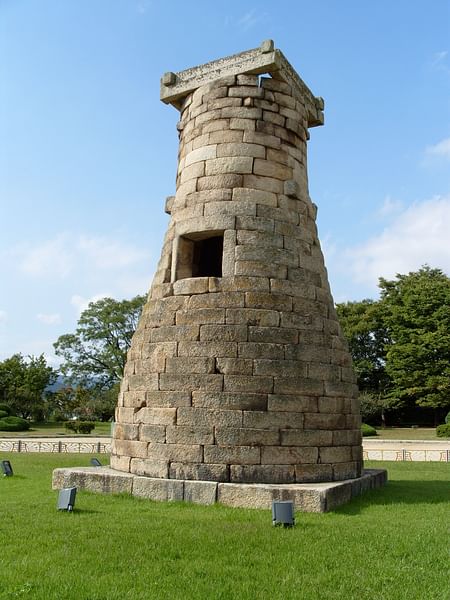
Bulguksa Temple
The Bulguksa Temple ('Temple of the Buddha Land') was built in the 8th century CE on the wooded slopes of Mt. Tohamsan. The chief architect of Bulguksa is traditionally credited as Gim Daeseong (700-774 CE), the Chief Minister or chungsi of the Unified Silla kingdom. As its name suggests it was designed to represent the land of Buddha, that is paradise. The temple complex, which includes a lotus lake and several bridges besides its three main halls, was so large and built with such precise mathematical and geometrical considerations that it took almost 40 years to complete, beginning with the traditional start date of 751 CE and finishing in 790 CE.
Although the original wooden buildings of Bulguksa are replacements for those originals destroyed by fire, the complex does have two original stone pagodas – the Dabotap ('Pagoda of Many Treasures') and Seokgatap ('Pagoda that Casts No Shadow') – which both traditionally date to 751 CE. Excavation around the latter pagoda in 1966 CE brought to light a sarira (reliquary casket) containing the world's oldest woodblock-printed document, a copy of the Dharani sutra.
Seokguram Grotto
Near the Bulguksa temple, set into the upper south-eastern slopes of the Tohamsan mountain, is the Seokguram Grotto. This Buddhist cave temple was constructed as an artificial grotto between 751 and 774 CE, again by Gim Daeseong. The circular inner chamber has a domed roof and a white granite statue of the Sakyamuni Buddha which is 3.45 metres high. The walls of the grotto are decorated with 41 figure sculptures set in niches. Seokguram features at position no. 24 on the official state list of National Treasures of Korea and it, along with the Bulguksa temple, has been designated a World Heritage Site by UNESCO.
This content was made possible with generous support from the British Korean Society.
